What to do if the toilet is clogged: how to diagnose the clog and remove it
Clogs are the most common plumbing problem.It can be caused by deposits of hard water salts, organic sediments and other debris that gets into the sewer pipe, narrowing its internal opening.
In some cases, a clogged toilet is the result of the actions of apartment owners who dump leftover food, fermented household ingredients and dirty water into it after cleaning the room. How to diagnose a blockage and what to do if the toilet is clogged without involving expensive specialists, let’s try to understand this material.
The content of the article:
Features of home sewerage
Sewage is an integral part of the drainage and water supply system. It is designed to remove liquid and solid products of human activity, to purify household water from contaminants and return them for further use or into a reservoir. A sewerage system is necessary for comfortable living in a house or apartment.
Residents of apartment buildings are responsible for the condition of sewer pipes in the apartment, and owners of private properties must independently install local treatment facilities, remove sewage, and maintain pipelines and equipment.
In order to avoid unpleasant problems in the future, you should comply with the requirements of SNiP regulations on water drainage and sewerage. Then the system will work normally, without requiring constant monitoring or adjustment.
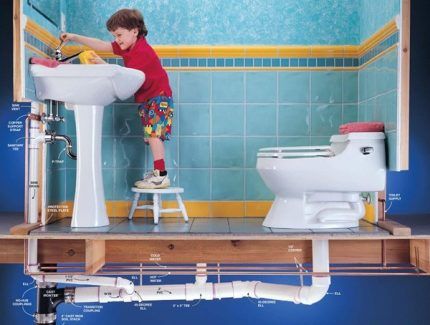
The internal sewer networks include:
- plumbing fixtures with water drainage;
- common riser, to which sewerage pipes are connected;
- pipe layout that ensures the process of transporting wastewater from the drain hole to the riser.
Requirements for internal networks are specified in SNiP “Internal sewerage”, in GOST and SNiP “Sewerage”. The systems are installed inside the building and ensure the transportation of all wastewater from the place of its formation to the pipe exiting the building.
Basic requirements for internal networks:
- When installing plumbing fixtures on drains, it is necessary water seal.
- Cast iron or plastic pipes are used for laying networks.
- The diameter of the sewer system outlet from the house is at least 110 mm.
- When laying pipes, a slope of 2 to 2.5% must be maintained.
The internal networks of the sewer system must be equipped with ventilation. The process of ventilating the networks is carried out through common sewer risers - an exhaust part is installed, leading to the roof.
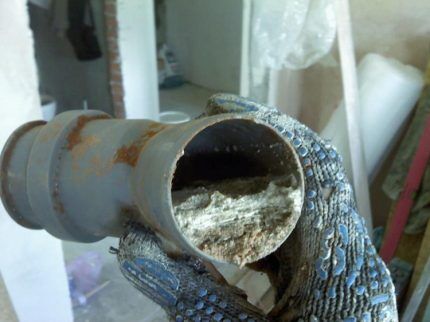
Due to the resulting blockages, normal drainage of wastewater becomes impossible, so it is necessary to immediately resume the full functioning of the sewer system. In order to avoid unpleasant consequences due to a blockage in the pipeline, you need to call specialists or clean the sewer yourself.
How is the sewage system arranged in apartments?
Sewage in modern apartments performs the task of removing human waste. For this purpose, a waste disposal line is installed from each point where waste is generated (toilet, sink and bathtub) to a common sewer riser.
Apartments located on adjacent floors are connected to it. The riser is a large pipe with a diameter of 0.1 m, located in the bathroom.
All sewer systems that are built in apartment buildings and private buildings must strictly comply with construction and sanitary standards.
Previously, only cast iron pipes were used for sewerage installations, but now mostly plastic ones are installed. In a plastic pipeline, the possibility of blockages is less likely, since defects do not appear on the walls, and “overgrowing” of the riser section occurs very rarely.
To make it easier to clean the riser in a high-rise, holes are made on each floor - sewer inspections.
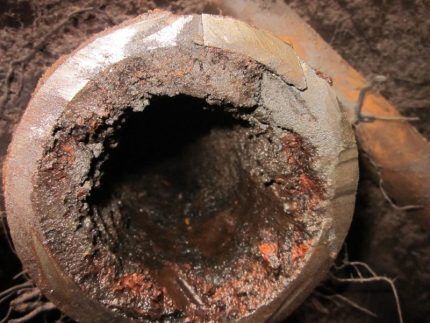
The standard configuration of a plumbing fixture (toilet, washbasin or bathtub) looks quite simple:
- device drain hole;
- siphon (a curved elbow that is connected to the waste disposal line);
- supply pipeline to the riser;
- large pipe or riser.
The blockage can be observed in any area, but it should be borne in mind that the cause of its appearance is man-made. If the plumbing fixture is used for its intended purpose, there should be no problems.
What to do if there are signs of blockage?
Every property owner should know what to do if the toilet is clogged in the bathroom. The first thing you need to do is warn your neighbors living on the floor above and ask them not to temporarily use the toilet, bathtub or washbasin. Then it is recommended to make a chop or kvach, which should be used to plug the drain hole.
Method for making the simplest chop:
- You need to take a wooden block about 0.5 m in length, the cross-section of which is 1 cm smaller than the toilet flush.
- The block should be wrapped in sheet foam rubber (1 cm thick) in several layers.
- You need to put several plastic bags on the “balda”, tying them with twine.
- The “buld” of the chop must be tightly installed in the drain hole.
After this, you can, with the help of your neighbors, find out the cause of the clogged plumbing fixture and determine the location of the clog.
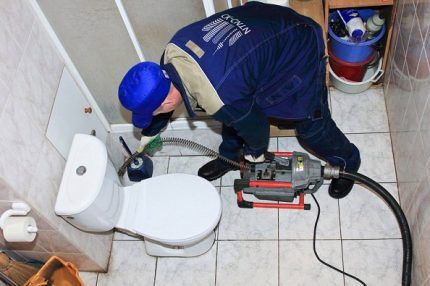
If the water drains slowly from the toilet, and everything is fine with your neighbors, then the blockage occurred before the line entered the sewer pipe. If there is a local blockage, you can call a plumber to your home, or you can try to eliminate the cause of its appearance yourself.
If the water in your toilet rises when the taps are closed and the tank is not drained, then the blockage is located lower down the common riser.
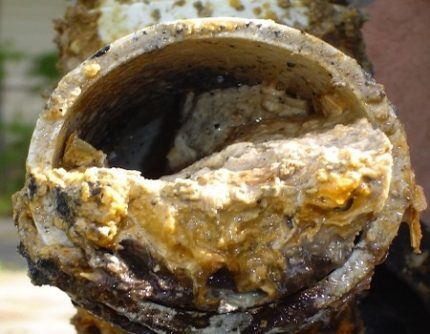
In most cases, unclogging a toilet or cleaning a sewer pipe can be successfully done on your own. Chemical and mechanical methods are used to clean pipes. The methods for removing blockages in an apartment building or in a private house are not fundamentally different.
The main reasons for a clogged toilet
The main task of the home owner is to promptly identify the problem of clogged plumbing and urgently take measures to eliminate it. If water stagnates in the toilet, it is necessary to act promptly, but first you need to determine whether the water is draining in the remaining sewer units (sink, shower, bathtub).
The main reasons for a clogged toilet:
- “overgrowing” of sewer pipes;
- improper operation of plumbing equipment;
- poor choice of model and errors when installing the toilet.
If the water gradually drains from the toilet, and everything is fine with your neighbors, then the blockage is located no further than the outlet of the main line into the sewer pipe. In case of local clogged plumbing, you can call a professional specialist, or you can try to fix the problem yourself.
The main reason for the slow drainage of water is the “overgrowing” of sewer pipes.
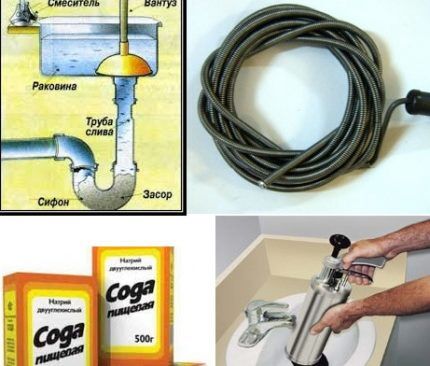
If the rules of operation of the sewer system are violated or due to sand, grease, hair and other insoluble substances entering the system, a blockage often occurs. The lumen of the pipe decreases and if the problem is not immediately eliminated, then compaction of the drain occurs, causing “paralysis” of the sewerage system.
As a result of clogged plumbing, the water stops partially or completely leaving, and an unpleasant odor appears in the bathroom. In order to eliminate this problem, it is necessary to clean the sewer.
Errors in the installation of plumbing equipment usually occur when choosing the wrong toilet model, which is not structurally compatible with the place where it is installed. The presence of this problem is indicated by an incorrect slope of the water drain line from the plumbing fixture to the riser. In rare cases, the design of the toilet contributes to the formation of blockages.
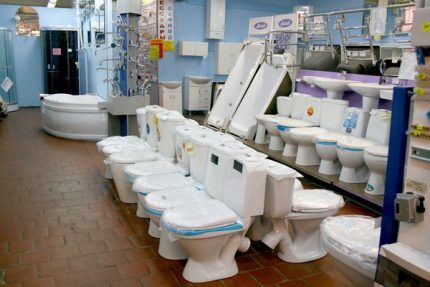
A clogged drain in an apartment building is a “public” problem, since it can be initiated by you or your neighbors, and collective participation is not excluded.
Clogging of liquid waste along the route within the apartment is your problem, so it is better to eliminate it yourself. Rags, cat litter, diapers, construction waste and other items that fall into the toilet are not considered liquid waste, so these blockages are quite difficult to remove.
We also recommend reading our other article, where we examined in detail the types of sewer blockages. If you are interested in details, go to link.
Effective ways to clear a clogged toilet
A blockage often forms in the sewer system, as a result of which the water stagnates and it becomes impossible to operate the plumbing equipment. At the same time, an unpleasant odor appears in the bathroom, which cannot be removed.
Before you begin cleaning your sewer pipes, you need to identify the source of the standing water. Typically, a clogged toilet is a result of improper use of the drain.

There are several effective ways to get rid of a clogged toilet on your own.
Method number 1 - cleaning pipes with vinegar and soda
If the sewer pipes are clogged in the bathroom, in most cases there is no need to seek help from professional plumbers. First, you can try to clean the sewer system yourself using water, vinegar and soda. This is a simple and effective way to clear sewer pipes from simple blockages.

Before you begin removing the blockage, you need to heat a bucket of water to boiling temperature, after which you need to pour the water into the problem toilet, creating a strong pressure. To do this, install the bucket in such a way that hot water pours into the toilet as quickly as possible and at a right angle.
If after cleaning the liquid begins to gradually disappear, the procedure must be repeated. These simple steps will help you deal with light blockages.
An equally difficult option for cleaning a clogged toilet is using vinegar and regular soda.The ingredients are poured into the siphon in equal quantities (2-3 spoons). After about 20-30 minutes they can be washed off with hot water. Despite the simplicity of performing the steps described above, removing the blockage yourself requires strict adherence to safety measures.
Method No. 2 - hydraulic cleaning
There are many methods for clearing a clogged toilet, so it’s difficult to say which one will help. By consistently applying different techniques, you can solve an unpleasant problem.
If you have a simple clog or it has just begun to appear, then you can pour several buckets of boiling water into the toilet using a hose.This method is used if the blockage is deep and the water drains slowly. It helps against organic blockages, sand and other small particles.

To do this, a special hose must be run into the drainage line. The other end of the hose must be connected to hot water. By adjusting the pressure to maximum pressure, you can wash away the clogged pipes until they dissolve.
When performing such cleaning, you should beware of backflow, so this method is used if the toilet is not completely filled with water, and there is a drain hole.
Method No. 3 - using household chemicals
Consumers can find solutions for clogged plumbing fixtures at home improvement stores. Effective special products in the form of granules, powders, sprays and liquids allow you to quickly and easily eliminate an unpleasant problem.
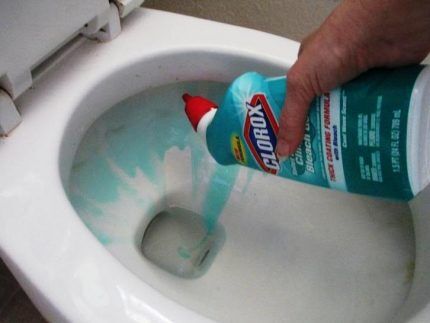
The chemical method helps with clogs caused by the presence of a large amount of organic matter in the toilet. Chemical products contain alkali, under the influence of which organic waste completely dissolves and forms a loose sediment.
When using them, it is necessary to avoid contact of alkali in the eye area and on the skin. After a while, the clog in the toilet dissolves and the water drains away.

Lye is not harmful to plastic or cast iron pipes. If the pipes are steel, then chemicals must be used carefully. Acid-based products can only be used for plastic pipes.
We talked about the most popular and effective means for clearing clogs in this article.
It should be noted that cleaning equipment once with special means does not always help; it must be repeated after a while. You can combine a chemical method of removing blockages with a mechanical one.
Chemical methods of influence can be successfully combined with mechanical ones, which is especially important for those who at a particular unpleasant moment do not have plumbing tools and fixtures:
Method No. 4 - plunger and its analogues
If the above methods do not have a noticeable effect on the blockage, then before calling plumbers, you can try to eliminate the unpleasant problem using a plunger with a rubber bowl with a diameter of 10 cm.
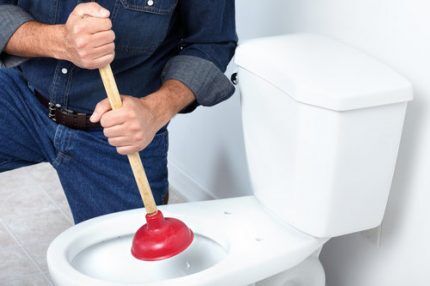
To obtain an effective result, you must first remove excess water from the toilet. The water should only cover the rubber part of the tool being used.
If the household does not have a plunger, and pipes are clogged and require immediate elimination, you can use a variety of homemade tools. Despite their rather primitive appearance, in most cases they turn out to be an effective and inexpensive means of solving an unpleasant problem.
You can use a plastic bottle with a pre-cut bottom. It is lowered into the drain hole with the cut end, after which sharp pressure is applied to the bottle. No less effective is a “pusher doll”, which can be easily made from rags and a long stick.
Before using the “doll” for its intended purpose, it is necessary to secure the rag well with improvised means.
If you have a used vacuum cleaner or the ability to completely disinfect the device after use, you can use the following equipment instead of a plunger:
Method No. 5 - cleaning the toilet with a steel cable
This method is effective when it becomes necessary to remove sanitary napkins, ropes, rags, etc. from the toilet. Organic and other waste usually gets caught on them, resulting in a clog in the plumbing equipment that cannot be removed by chemical means.
A plumbing flexible cable is a hollow rigid axis that is equipped with a rotating handle. Every plumber has this tool. A spiral tip or a pointed wire nozzle is attached to the end of the cable, allowing the blockage to be destroyed. The thickness of the cable is up to 5 mm, and its length should reach the sewer riser.
Read about what types of sewer cleaning cables there are Further.
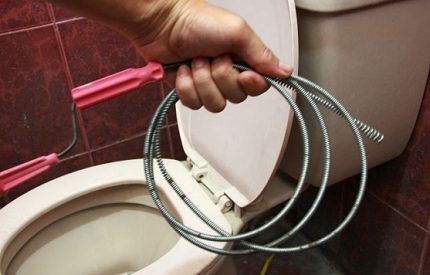
To break through the blockage mechanically using a cable, the spiral end of the tool is lowered all the way into the toilet. Then rotate the handle clockwise to push the tool into the water seal.
What to do if the cable encounters an obstacle:
- if the tool rests on the back of the toilet bowl, you must continue pushing until it slides deeper;
- if the movement of the cable is impeded by the vertical wall of the riser, then a tool with a length of more than 1.5 m is required;
- if the toilet has a direct outlet, the cable is pushed horizontally along the pipe to the riser. The tip of the cable may encounter a blockage, which must be pushed into the riser using forward and backward movements.
If you eliminate cable blockage yourself, then this must be done carefully and not only before the process of eliminating standing water.
When using the mechanical method of cleaning plumbing, it is necessary to treat the clogged area several times, accompanying the cleaning of the toilet by rinsing with hot water.
To destroy organic deposits on the walls of pipes, two buckets of hot water should be poured into the toilet at least once a month. A mandatory preventative measure is cleaning siphons with special chemicals.
Conclusions and useful video on the topic
The videos will help those who want to remove a clogged toilet on their own and visually learn several ways to eliminate the unpleasant problem.
An easy way to remove clogged plumbing equipment using homemade tools:
Non-standard methods for cleaning the toilet:
We have listed the signs and main causes of a clogged toilet in an apartment and in a private house. Depending on the cause and complexity of the clogged plumbing equipment, you can choose the best way to fix the problem. Using a chemical, mechanical or complex method of removing the blockage will help solve the problem.
If you know of other equally effective ways to unclog a toilet, please share them with visitors to our site. Leave comments, ask questions, share your experience in the block located under the article.




I encountered the problem of a clogged toilet when I lived in a rented apartment. I came home late in the evening and water was pouring out of the toilet. I rented an apartment in a nine-story building, it was on the first floor. It was night outside, and I was running around all the apartments up the riser and asking them not to use the toilet. The emergency service arrived and the plumber found out that someone had simply thrown out the dirty diaper and washed it away. The blockage is not always the fault of the owner; sometimes you need to “thank” the neighbors above.
Quite complex methods are described; I always managed it with the help of a plunger. Although this method is not the most pleasant. It didn’t occur to me to use hot water pressure, but it’s very simple and effective; last year I broke through a blockage in the kitchen.And this is also the first time I’ve heard about baking soda and vinegar. You need to remember it just in case, otherwise our pipes are old and might get clogged.
Chemicals can only break through small blockages; hydraulic cleaning is an interesting method, but I can’t imagine how to do it at home on my own. So that leaves mechanical ones, they are also the most effective - a plunger and a plumbing cable.